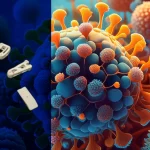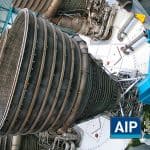
Torlon® Takes the Heat in Mission-Critical Aerospace Components
Few businesses on the planet share the same level of scrutiny towards their components as those in the aerospace industry. The material properties of Torlon® are what make the high-performance thermoplastic a top material pick in the industry.
To pass the benchmark, aerospace components must be:
- – Impervious to corrosive and oxidizing chemicals
- – Able to function in both cold and hot environments
- – Lightweight to reduce overall vehicle weight and increase payload
- – Strong enough to withstand constant friction, impact, wear, temperature extremes, and high pressures
Few polymer materials can check all those boxes, but Torlon® is among them. For decades aerospace OEMs have relied on Torlon® to solve unique challenges in the aerospace and defense sector. One of its most outstanding properties is the ability to maintain mechanical stability at extreme temperatures. For this reason, it’s often used for bushings, fasteners, and screws in Boeing 787s and even F-16 fuel and air connectors.
Properties of Torlon®
 Besides incredible thermal stability and resistance rivaling aluminum, copper, and steel, Torlon® is well known for its strength under pressure and chemical resistance. Torlon’s benefits include the following:
Besides incredible thermal stability and resistance rivaling aluminum, copper, and steel, Torlon® is well known for its strength under pressure and chemical resistance. Torlon’s benefits include the following:
- – Wear resistance in dry and lubricated environments
- – Maintains strength and stiffness up to 500°F (260°C)
- – Low-temperature toughness and impact strength
- – Chemical resistance, including acids and most organics
- – Low creep and wear under load
- – Excellent compressive strength and extremely low CLTE
- – Low flammability and smoke generation
→ Discover our precision plastics
High-Temperature Wear Resistance
Torlon® falls within the family of imidized performance polymers. Celazole® (PBI), VESPEL® (PI), and Torlon® (PAI) all perform at elevated temperatures up to and above 500°F (260°C). These grades of thermoplastics have resistance to chemicals, steam, and wear. Torlon® PAI is often accepted as a metal replacement in aerospace applications where temperatures range from cryogenic to extreme heat, and the application requires thermal/electrical insulation and weight reduction.

Torlon® Solves Tough Aerospace Challenges
Torlon® has been a critical material for many years with industries relying on its innate qualities to solve complicated challenges. How can Torlon® do the same for the aerospace industry? Consider the following:
1. Boeing thermal isolators – Increasing fuel efficiency by reducing aircraft weight is a constant goal for the aviation industry. In the case of the Boeing 787, Torlon® was able to help make that goal attainable. The engineers at Boeing theorized they could reduce the overall weight of the aircraft by feeding hydraulic lines through the fuel tanks rather than around them. For this to work, the hydraulic lines needed insulation that could handle being exposed and heated by harsh environments. Torlon® 4203 PAI was a perfect choice because it does not conduct heat nor electricity, which would have caused problems, as temperatures range from -40°F (-40°C) up 350 F (177°C).
2. Boeing bushings for blocker doors – Blocker doors allow the aircraft to slow down by creating a reverse thrust. The doors must be precise, and that task falls to the bushings in the hinge assembly. They must maintain a low friction and wear rate while surviving temperatures ranging from -40° to 500°F (260°C), and all without lubrication. Torlon® 4301 PAI provides all these needed properties.
3. Worldwide Aviation fastening screws – Aerospace OEMs need screws made from a material that can provide a capacity for heavy load-bearing while being optimized for production. In the case of radar systems, the screws also need to be made out of a material that won’t interfere with detection capabilities. For that reason alone, metal screws are out, as they’ll interfere with the radar’s ability to function. Torlon® 4203, on the other hand, is both RFI and EMI transparent, it doesn’t corrode, and it has a fantastic strength-to-weight ratio.
4. F-16 fuel and air connectors – With auxiliary tanks, the F-16 can take on the role of a strategic bomber, as its range is extended by a full 50%. At first, the fuel connectors were made from stainless steel but required additional insulation against lightning strikes, rendering metal connectors infeasible. Finding an alternative material proved difficult due to other variables; it needed to be resistant to temperatures up to 400°F (205°C), be chemically resistant to jet fuel, and handle constant vibrations. Torlon® 4203 was the answer, as it reached all those requirements while also handling pressures beyond 650 psi. This choice improved both the part performance and manufacturing costs.
In all of these real-world examples, Torlon® demonstrates its superiority in strength and thermal stability. The fact that it’s successfully used in critical applications is proof of the material’s reliability.
AIP, Unparalleled Results in Aerospace-grade Torlon® Machining

Advancements in aerospace design keep defense technology at the forefront. Material design with precision plastics is a core part of this evolution. High-performance plastics like Torlon® provide lightweight characteristics and mechanical stability even at extreme temperatures above 500°F (260°C). Aerospace contractors look for precision and consistent results in machined precision plastics.
As a global leader in precision performance plastics, AIP understands how one single machined part contributes to the efficacy of an entire aircraft. We have machined complex geometries with .002 mm precision. Our machinists have over 40 years of experience working with defense OEMs. From Torlon to PEEK or Vespel®, our material design vetting process aims to produce a final piece that does more than meet criteria; it accelerates the mission and contributes to your entire bottom line.
Talk to our machinists and engineers today about your aerospace application; we can provide you with a design and part prototype oftentimes within ten business days.






